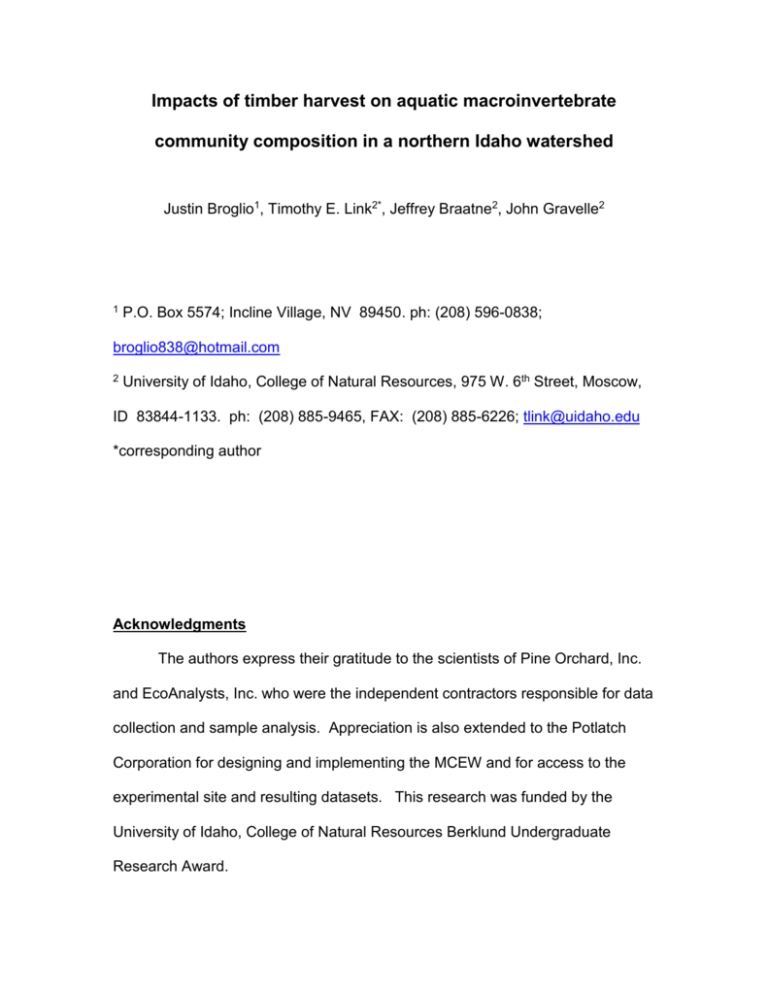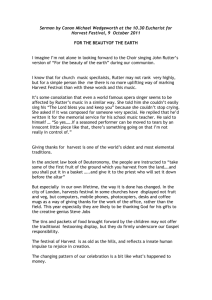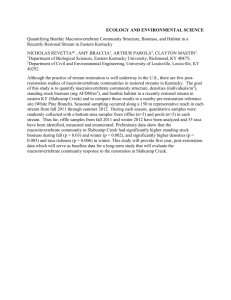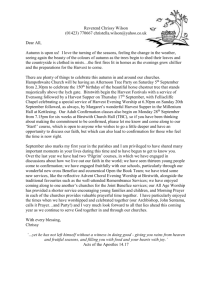Impacts of Forest Harvest on Aquatic Macroinvertebrate Community
advertisement

Impacts of timber harvest on aquatic macroinvertebrate community composition in a northern Idaho watershed Justin Broglio1, Timothy E. Link2*, Jeffrey Braatne2, John Gravelle2 1 P.O. Box 5574; Incline Village, NV 89450. ph: (208) 596-0838; broglio838@hotmail.com 2 University of Idaho, College of Natural Resources, 975 W. 6th Street, Moscow, ID 83844-1133. ph: (208) 885-9465, FAX: (208) 885-6226; tlink@uidaho.edu *corresponding author Acknowledgments The authors express their gratitude to the scientists of Pine Orchard, Inc. and EcoAnalysts, Inc. who were the independent contractors responsible for data collection and sample analysis. Appreciation is also extended to the Potlatch Corporation for designing and implementing the MCEW and for access to the experimental site and resulting datasets. This research was funded by the University of Idaho, College of Natural Resources Berklund Undergraduate Research Award. 2 Abstract Timber harvest and road construction in mountainous watersheds have the potential to impact stream temperature, light and flow regimes, primary production, organic matter, fish and aquatic macroinvertebrates. The effects of contemporary timber harvest practices on aquatic macroinvertebrates were studied in a northern Idaho watershed. Macroinvertebrate assemblages are commonly used to assess the potential effects of timber harvest on stream ecosystems. In this study, the structure and diversity of macroinvertebrate assemblages were compared in 50% clear-cut, 50% partial-cut, and control catchments. Three macroinvertebrate taxa were specifically used as bioindicators of stream habitat quality: Ephemeroptera (mayflies), Plecoptera (stoneflies), and Trichoptera (caddis flies), “EPT”. In relation to pre-harvest conditions, there were no major changes in functional feeding group composition or species diversity. However, changes were observed in macroinvertebrate abundance and EPT richness and abundance. Long-term and detailed food web studies are needed to fully assess these responses to clear-cut and partial-cut harvesting practices. KEY TERMS: aquatic macroinvertebrates; water quality; timber harvest; Pacific Northwest; Mica Creek 3 Introduction and Background Forest harvest practices have changed dramatically over the last century, with increased emphasis on methods to decrease adverse impacts on aquatic ecosystems. Forest harvest can affect several aspects of stream ecosystems including temperature, light and flow regimes, primary production, organic matter dynamics, and macroinvertebrate community structure (Stone and Wallace 1998). Forest harvest and road construction in mountainous watersheds also have the potential to increase the amount of fine sediment entering streams (Haggerty et al. 2004). These sediment inputs can potentially impact all biotic components of stream ecosystems (Relyea et al. 2000). Macroinvertebrates are valuable bioindicators to assess the effects of forest harvest due to their sensitivity to changes in sediment, organic matter, temperature, and light levels (Haggerty et al. 2004). Sediment inputs may have positive, negative, or neutral effects on macroinvertebrate communities, depending on the quantities involved, geologic characteristics, nature of the streambed, composition of flora and fauna, and time of year (McClelland 1972). There are several other environmental variables related to macroinvertebrate community composition, including sediment composition and particle size (Peeters et al. 2004), streamside vegetation, hyporheic and near-bed flows, and longitudinal and downstream hydraulic gradients, that control the input and dynamics of organic matter, nutrients, temperature, and light (White 1997). 4 The impacts of forest harvest on macroinvertebrate community structure within a given reach are controlled by complex interactions between species assemblage, watershed physiography, hydroclimatic regime, and the type and extent of land cover alteration. In a low gradient sand-bottomed stream, clear-cut logging was noted to alter species composition, richness and proportional abundance of functional feeding groups, with an increase in collector-gathers and scrapers and a decrease in shredders (Kedzierski and Smock 2001). A similar trend of increasing scraper abundance and a decline in shredder abundance after clear-cutting was also noted in a low elevation oak (Quercus spp.) and hickory (Carya spp.) watershed in North Carolina (Stone and Wallace 1998). In a sub-boreal forest, macroinvertebrate densities increased immediately after clearcutting as a result of increased light levels, which increased primary production (Fuchs et al. 2003). These studies reveal the range of responses that may arise between streams, indicating the need to improve our understanding of macroinvertebrate responses to disturbances both within and between a broad range of stream ecosystems. In the relatively pristine (i.e., no significant disturbances for ~70 years) Mica Creek Experimental Watershed (MCEW), initial biological assessments revealed considerable variation between the upper, middle, and lower stream reaches, with shredders and collectors dominating upper reaches (White 1997). This initial study also determined that taxa richness had no relationship to stream size, and that collector-filterers were constant among sites. A high degree of taxonomic variation was observed throughout the watershed, but this variation 5 was related to habitat changes along the stream continuum (White 1997). This and other studies also established sediment tolerances for macroinvertebrates (Relyea et al. 2000) and provided a base of knowledge on aquatic insect community structure and diversity prior to road construction and timber harvest (White 1997). The primary objective of this research was to assess temporal differences in macroinvertebrate community composition and species diversity before and after timber harvest in a 50% clear-cut catchment and a 50% partial-cut (i.e. thinned) catchment with 50% canopy removal in harvested areas. The secondary objective of this research was to assess the degree of post-harvest disturbance in upper headwater reaches, which were expected to sustain greater impacts on aquatic macroinvertebrates. Methods Site Description This research was conducted in the Mica Creek Experimental Watershed (MCEW), a 27 km2 watershed located in Shoshone County, northern Idaho (Fig. 1). The MCEW is privately owned by Potlatch Corporation and managed primarily for timber production (Schultz 2000). Streamflow, water quality, and aquatic ecological conditions have been monitored since 1991 as part of a comprehensive study of contemporary forest harvest practices on headwater streams. 6 Mica Creek is a tributary of the St. Joe River and the research area includes the headwaters of the west fork and main stem of Mica Creek. Experimental catchments range from 1000 to 1600 m (amsl), with stream gradients ranging from 5 to 20 percent. Average annual air temperature is 5 oC, and average annual precipitation is approximately 1450 mm, over half of which typically falls in the form of snow. In the early 1900s, approximately 95% of the overstory canopy was removed from the Mica Creek Basin using historic harvesting techniques (Schultz, 2000). Large-scale sediment movement was the most common effect associated with these logging practices. By the early 1930s, logging ceased in upper Mica Creek. In December 1933, a large rain-on-snow flood event damaged the central flume beyond repair and flushed a significant amount of sediment through the Mica Creek stream network (Schultz 2000). The site has remained relatively undisturbed since the early 1930s and is typical of many second-growth forests in the region. Experimental Treatments Recent harvest activities were initiated in late 1997 with the construction of a main access spur road. After road construction, four years of post-road data were collected prior to harvesting in the summer and fall of 2001. The clear-cut area was broadcast burned and replanted with conifer seedlings in late May 2003. Two of the three sub-watersheds that drain into Flume 4 (Fig. 1) were harvested using a mobile cable system (steeper sections of the watershed) and 7 rubber tire skidders (lower gradient areas). Timber harvest followed Idaho Forest Practice Act guidelines, leaving 75 % of existing shade in Class I Stream Protection Zones (SPZs) and operating equipment outside a 75 foot buffer in the Class I fish-bearing streams and a 30 foot buffer in the Class II non-fish bearing streams. Drainage features were also installed along skid trails to control erosion. The clear-cut catchment (50% canopy removal) drains to Flume 1 (Fig.1), the partial-cut catchment (25% total canopy removal) drains to Flume 2, the control catchment drains to Flume 3, and Flume 4 is the cumulative site downstream of for all three catchments. Physical characteristics for these four sites are summarized in Tables 1 and 2. This study used macroinvertebrate data collected over five years near the four stream-gauging stations. These data were used to assess the cumulative potential effects of timber harvest techniques on macroinvertebrate populations. This study also established four new sampling points (paired design) to assess impacts in upper watershed reaches. This included two sites located in the clearcut zone, one in the partial-cut zone, and one in the control zone. These reaches were located in the central timber harvest areas, contain smaller riparian buffers and higher numbers of road/stream crossings. These additional sites provided EPT abundance data for stream reaches that had not been previously sampled, but which were expected to sustain greater impacts relative to the flume sampling sites. 8 Macroinvertebrate Sampling Protocol Macroinvertebrates were sampled in the thalweg of riffles below the flume at each gauging site. Sample sites were 40 times the wetted width of the stream and ranged from 50 to 75 m in length. Five randomly placed benthic samples were taken at each site with a modified Hess sampler (36 cm diameter sample area, 250 µm mesh net). These methods were necessary to sample the small headwater environments within the MCEW. Samples were taken at the lowest riffle and preceded upstream within the designated stream reach with no more than one sample per riffle. Samples were placed in one quart glass jars and preserved in a 70% alcohol solution (White 1997). These sampling protocols were also followed in upper watershed reaches, though study reaches were shorter in length (25-50 m). Four supplemental post-timber harvest macroinvertebrate sample sites above the flumes were chosen in the headwater regions of Mica Creek in July 2003. These regions of the MCEW are located in the central timber harvest areas, contain smaller riparian buffers and higher numbers of road/stream crossings, and stream segments are relatively short in length. These areas in the MCEW were likely to sustain greater impacts as a result of the disturbances; therefore, it is important to understand how the aquatic community is structured across these areas. 9 Data Analysis Macroinvertebrates collected at the flume sites were identified to genus, and species (when possible) by EcoAnalysts Inc. (Moscow, ID). Data were sorted and graphed, with a Multivariate Analysis of Variance (MANOVA) to identify significant differences in specific taxa (Ephemeroptera, Plecoptera, and Trichoptera, or EPT) and overall macroinvertebrate abundance. Statistical analyses were completed using the StatistiXL data analysis package. All data were ln(x+1) transformed to meet MANOVA assumptions of independence, normality and homogeneity of variance (Benfield 1996, Chamberlain and Braatne 2006). Average percent composition of macroinvertebrate functional feeding groups (collectors-filters, collectors-gathers, scrapers, shredders, and predators) were also sorted and graphed. In addition to abundance values and functional feeding groups, four other indices (EPT richness, predator richness, scraper richness, and Shannon-Weiner H’ log e) were used to determine macroinvertebrate community richness and species diversity. Indices were sorted and graphed, with a MANOVA to assess significant differences. EPT richness, defined as the total number of identifiably distinct taxa in the insect orders Ephmeroptera, Plecoptera, and Trichoptera, was used to characterize macroinvertebrate richness at flumes 1-4. Predator and scraper richness was used to characterize changes in allocthanous and autochthanous inputs. Shannon-Wiener H’ log e, a common community diversity index, was used to estimate macroinvertebrate diversity. 10 The data that were collected during the year harvesting occurred (2001) were not included in the statistical analysis of pre- and post-harvest macroinvertebrate communities. Impacts of harvesting were considered to occur continuously and increase over the course of this year, whereas the sampling occurred at a discrete point in time. For example, although the impact of reduced shade likely affected the headwater streams prior to the macroinvertebrate sampling, increased sedimentation was not observed until flows increased after sampling (Karwan and Gravelle, this issue). This year was therefore removed to eliminate any partial impact effects and to directly compare years that are representative of actual pre- and post-harvest conditions. It is important to note that the macroinvertebrate community structure during this year was very similar to both the pre- and post-harvest conditions. Taxonomic identification (EPT abundance) of the headwater macroinvertebrate samples collected in 2003 was completed in the University of Idaho, College of Natural Resources laboratory. Samples were filtered through a # 40 U.S.D.A standard testing sieve and then identified to order using keys provided by Merritt and Cummins (1996). The total numbers of individuals in each of the three orders of concern were sorted by site and an average was calculated from the five replicate samples taken at each site. 11 Results and Discussion Macroinvertebrate Abundance A distinct increase (P = 0.014) in macroinvertebrate abundance values followed timber harvest in 2001 (Figure 2). Abundance values in the clear-cut catchment increased from 250 individuals per site prior to harvest (2000) to 656 (2002) and 600 (2003) individuals per site following timber harvest. These values represent the overall macroinvertebrate community (e.g. Ephemeroptera, Plecoptera, Coleoptera, Diptera, Chironomidae, Trichoptera, Lumbricina, Oligochaeta, Bivalvia, Gastropoda, Ostracoda, Tricladida, and Acari). The largest increase in macroinvertebrate abundance was observed in the clear-cut and cumulative sites. This increase could be related to several different variables, or interactions between altered variables. Because clear-cutting increased annual water yield by approximately 30 % (Hubbart et al. this issue), changes in sediment quality and depositional patterns may contribute to community increases. Increases in fine substrate, amount of riparian cover, slash, stream cover, and mean water temperature are highly correlated with variation among macroinvertebrate assemblages in headwater streams (Banks et al. 2005). Clear-cutting above Flume 1 increased stream temperatures in harvested reaches (by 1.6 to 3.5 °C), but slightly reduced (by ~0.3 °C) stream temperatures at the flume sites (Gravelle and Link this issue). Temperature changes, coupled with increased flows that may have increased oxygenation, may have contributed to increased population densities. Additional research is needed to identify the specific processes underlying these observations. 12 EPT Abundance Average EPT abundance increased significantly (P = 0.001) following timber harvest (Fig. 3). The most dramatic increases were seen in the clear-cut and cumulative catchments. EPT abundance values in the clear-cut catchment increased from 97 individuals prior to harvest, to 276 individuals after harvest. EPT abundance values in the cumulative catchment increased from 471 individuals prior to harvest, to 801 individuals after harvest. Although a small increase in EPT abundance was seen in the control reach, it was not as dramatic as the 179 individuals increase observed in the clear-cut catchment. Therefore, it can be assumed that cumulative effects of timber harvest (i.e., increased flows, changes in sediment quality and depositional patterns, temperature and light changes) increased populations of Ephemeroptera, Plecoptera, and Trichoptera. Jackson et al. (2005) found that EPT abundance increased after timber harvest in six clear-cut catchments in the Washington Coast Range, which was related to increased primary productivity from decreased slash cover and increased insolation. EPT abundance increased during and after harvest in all study reaches, and returned to pre-treatment levels two years (2003) after harvest, therefore supporting the assumption that timber harvest increased EPT abundance. 13 EPT Richness Average EPT richness values (Fig. 4) were compared at each sample site over a four-year period before and after timber harvest. There were no significant differences between clear-cut and partial-cut reaches and the control reach (P = 0.676). However, EPT richness values at the cumulative site (Flume 4) declined moderately after timber harvest, later increasing toward pre-treatment values by 2003. Because Flume 4 is downstream of catchments 1, 2, and 3, this downstream decline in EPT richness may be associated with the increased flows (Hubbart et al. this issue), or sediment flux (Karwan and Gravelle this issue) related to timber harvest. This decline in downstream EPT richness could also be linked to the observed decrease in scrapers or an increase in predators (described below). Shannon-Wiener H (log e) – Diversity Index Shannon-Wiener values are a common index of species diversity. The Shannon-Wiener Index can be estimated with the natural log (ln), log 2, or log 10 data transformation. In this study, these values were natural log transformed to meet independence, normality and equality of variance assumptions associated with statistical analyses. The Shannon-Wiener (log e) values were higher than 2.5 in all sample years (Fig. 5), indicating high levels of species diversity in all study reaches. Diversity values at Flume 1 (clear-cut) and Flume 4 (cumulative) both correspond to the natural variation observed at Flume 3 (control stream). Patterns observed 14 in the control reach showed a progressive increase from 2.96 to 3.22 after harvest (2002), and again from 3.22 to 3.35 (2003). There was a significant difference between all the Shannon-Wiener values (P = 0.039), therefore suggesting the increase in Shannon-Wiener diversity values can be related to natural variation. Functional Feeding Groups Functional feeding groups (e.g. collector-gatherers, collector-filterers, shredders, scrapers, and predators) were quantified at each study site from 1999 through 2003 (excluding the 2001 harvest year). The dominant functional feeding group at all four flume sites was collector-gatherers (Fig. 6). Collector-gatherer compositions were high (52 % on average) before and after timber harvest and therefore do not appear to be impacted by harvest disturbances (Fig. 6). White (1997) also observed collector-gatherer dominance prior to timber harvest. An increase in predators was observed during the study period, but this pattern was also seen at the control site (Flume 3). Thus, increases appear to be due to natural population cycles, climatic variability, and concomitant impacts on flow and sedimentation (Fig. 6). The dominant functional group associated with most headwater streams are shredders, while collectors are generally associated with network stream systems (Gomi et al. 2002). However, scrapers might predominate in streams impacted by recent clear-cuts, with shredders dominating streams with denser riparian canopies (Fuchs et al. 2003). Collector-gatherers are correlated with fine 15 particles and commonly found in depositional areas. Kedzierski and Smock (2001) noted that an increase in both collector-gatherers and scrapers, and a decrease in shredders can be attributed to timber harvest. Stone and Wallace (1998) found that collectors were three times more abundant in clear-cut stream reaches. They also noted a marked drop in shredder abundance immediately after clear-cutting. The functional feeding group data observed in the MCEW differs from these studies, as collector-gathers dominated each sample site and scrapers declined in the clear-cut, control, and cumulative catchments. This result could be due to several interacting factors, including the geologic, hydroclimatic and biophysical characteristics of this area. The composition of functional feeding groups in the MCEW were related directly to the studies by Herlihy et al. (2005) and Cole et al. (2002). Herlihy et al. (2005) found that almost half (49 %) of functional feeding group assemblages in headwater streams were composed of collector species, whereas the remainder where evenly divided among scrapers, shredders and predators. Cole et al. (2002) found that collector-gatherers where the most abundant functional feeding group, averaging 45 % of the sampled assemblages. Scraper and Predator Richness Average scraper and predator richness values are shown in Figure 7 for each site from 1999 to 2003. There was an increase in predator richness from 2000 through 2003 in all catchments. Since there was no statistical significance between the experimental catchments (P = 0.184), this observation suggests that 16 this pattern was not related to timber harvest. This increase in predator richness follows the increase in predator abundance noted above, but since the control sites showed the same trend as the experimental treatment sites, this increase appears unrelated to timber harvest. Declines in scraper richness after timber harvest (2002, 2003) were not statistically significant (P = 0.487). In contrast to the study by Kedzierski and Smock (2001), there was a decrease in scrapers and an increase in predators. Kedzierski and Smock (2001) sampled a low gradient sand-bottomed stream, whereas stream gradients of MCEW ranged from 5 to 20 %. The streambed geology in the MCEW is also gneiss/quartzite parent material, overlain by silty loams and would probably not contain the same macroinvertebrate assemblages found by Kedzierski and Smock. Hence these differences appear related to differences in the biophysical environments of these two study areas. Headwater Data Since upper headwater sites were only sampled once, longer-term data were not available for temporal comparisons. However, these data were useful to assess macroinvertebrate assemblages along more heavily impacted reaches. EPT abundance was used as a bioindicator in both disturbed and undisturbed headwater reaches of Mica Creek (Fig. 8). In comparision with Herlihy et al.(2005), who found that 55 % of the taxa observed in headwater reaches were in the orders Ephemeroptera, Plecoptera, or Trichoptera, EPT values in the additional MCEW headwater sites followed more natural patterns of abundance. 17 There were slightly higher EPT abundance values in the control relative to the clear-cut reaches (Figure 8a) and a much higher abundance of Plecoptera at all four sites (Figure 8b). Plecoptera abundance values in the clear-cut headwaters and the control headwaters were 13 % higher than partial-cut headwaters. Overall, Plecoptera abundance values in the headwater regions of the MCEW were 132 % higher than Ephemenoptera abundance values and 48 % higher than Trichopetra abundance values. Futher investigation is warranted to determine a more comprehensive impact on the invertebrate communities in the headwater regions of the MCEW. Future directions The objectives of this investigation were to assess the general changes on the macroinvertebrate communities before and after timber harvest, and how the degree of disturbance in the directly impacted headwater reaches was reflected in the macroinvertebrate assemblages. There are a number of future investigations beyond the scope of this initial assessment that would be useful to explore to more fully understand the subtleties of macroinvertebrate response to disturbance. Specifically, it would be beneficial to examine specific taxa, such as Baetis, Perlidae, and Limnephilidae sp., which are more sensitive to habitat change. Isolation of dominant taxa in each functional feeding group could also help explain why collector-gathers dominate the upper catchments of the MCEW. It would also be useful to assess the specific mechanisms that produced the observed changes through multidisciplinary investigations of the biophysical, 18 biogeochemical and ecological changes associated with timber harvest in headwater systems. Ongoing investigations include an assessment how macroinvertebrate changes are propagated to higher trophic levels through riparian food web analyses in systems with a range of disturbance intensity. Conclusions Overall, macroinvertebrate communities were relatively stable. There were no major changes in functional feeding groups or EPT richness values in relation to timber harvest. The only statistically significant changes in community structure were increases in macroinvertebrate and specific taxa (EPT) abundance. Although a decrease in EPT richness was observed at the cumulative site, it was not significant and further research is needed to identify the specific mechanisms that are likely to have produced these observed changes. Further research is also needed to determine if the observed changes will remain in the years following forest harvest and if the increased abundance values will alter food webs or other stream ecosystem components. 19 References Banks, J., A.T. Herlihy, and J. Li. (2006- in preparation). Influence of forest harvest on aquatic insect emergence from perennial and intermittent headwater streams in the central Oregon Coast Range. Benfield, E.F. 1996. Leaf breakdown in stream ecosystems. P. 579 – 589 in Methods in Stream Ecology, Hauer, F.R. and G.A. Labertii (eds.). Academic Press Inc., San Diego. Chamberlain, E. and J.H. Braatne. (2006 – in press). Leaf decomposition and stream macroinvertebrate colonization of Japanese knotweed, an invasive plant species. Hydrobiologia. Cole, M.B., K.R. Russell, and T.J. Mabee. 2003. Relation of headwater macroinvertebrate communities to in-stream and adjacent stand characteristics in managed second-growth forests of the Oregon Coast Range mountains. Can. J. For. Res. 33:1433-1443. Fuchs S.A., S.G. Hinch, and E. Mellina. 2003. Effects of streamside logging on stream macroinvertebrate communities and habitat in the sub-boreal forests of British Columbia, Canada. Can. J. For. Res. 33:1408-1415. 20 Gomi T., R.C. Sidle, and J.S. Richardson. 2002. Understanding processes and downstream linkages of headwater systems. Bioscience 52(10):905-915. Haggerty, S.M., D.P. Batzer, and C.R. Jackson. 2004. Macroinvertebrate response to logging in coastal headwater streams of Washington, U.S.A. Can. J. Fish. Aquat. Sci. 61:529-537. Herlihy, A.T., W.J. Gerth, J. Li, and J.L. Banks. 2005. Macroinvertebrate community response to natural and forest harvest gradients in western Oregon headwater streams. Freshwater Biol. 50:905-919. Hubbart, J.A., T.E. Link, J.A. Gravelle, and W. Elliot. (2006 – in review). Timber harvest impacts on hydrologic yield in the continental/maritime hydroclimatic region of the U. S. For. Sci. this issue. Jackson, R.C., D.P. Batzer, S.S. Cross, S.M. Haggerty, and C.A. Sturm. (2006 in preparation). Abiotic and biotic responses of headwater streams to adjacent timber harvest: Results of a four-year manipulative study. Karwan, D.L. and J. A. Gravelle. (2006 – in review) Effects of current timber harvest practices on suspended sediment loads in Mica Creek, Idaho. For. Sci. this issue. 21 Kedzierski W.M. and L.A. Smock. 2001. Effects of logging on macroinvertebrate production in a sand-bottomed, low gradient stream. Freshwater Biol. 46:821833. McClelland, W.T. 1972. Effects of introduced sediment on the ecology and behavior of stream insects. Ph.D. dissertation, Univ. of Idaho, Moscow, ID. Merritt R.W. and K.W. Cummins (eds). 1996. Aquatic insects of North America. Kendall Hunt Publishing Company, Dubuque, Iowa. 862 p. Peeters, E.T.H.M., R. Gylstra, and J. Vos. 2004. Benthic macroinvertebrate community structure in relation to food and environmental variables. Hydrobiologia. 519:103-115. Relyea, C.D., G.W. Minshall, and R.J. Danehy. 2000. Stream insects as bioindicators of fine sediment. Idaho State University, Boise Cascade Corp & Water Environment Federation, Pocatello, ID. Schultz, R. 2000. Land Use History: Mica Creek – A tributary of the St. Joe River University of Idaho. http://www.cnr.uidaho.edu/micacreek/publications/MC_History.pdf. January 15, 2006 22 Stone M.K. and J.B. Wallace. 1998. Long-term recovery of a mountain stream from clear-cut logging: the effects of forest succession on benthic invertebrate community structure. Freshwater Biol. 39:151-169. White, J. S. 1997. A multi-trophic level aquatic bioassessment of a North Idaho watershed. M.Sc. thesis, Univ. of Idaho. Moscow, ID. 23 Table 1. Watershed characteristics and experimental treatments Watershed/ Size Flume Number (acres) 1 350 Treatment 50% of watershed area clearcut, 2 cutblocks, 180 acres total 2 400 50% of watershed area partial cut, with 50% canopy removal in cut areas, 200 acres total 3 500 Control (no impact) 4 1250 Cumulative site comprised of watersheds 1-3 24 Table 2. Aquatic macroinvertebrate sample site characteristics Wetted Width Bankfull width Gradient Substrate size Flume (m) (m) (%) (d50, mm) 1 1.5 2.1 5 50 2 2 2.4 8 50 3 2 2.5 14 70 4 3 3.9 3 40 25 Table 3. Statistical significance of post-harvest changes to macroinvertebrate metrics Metric P value Overall Abundance 0.014 EPT Abundance 0.001 EPT Richness 0.676 Shannon-Wiener (H) 0.039 Scraper Richness 0.487 Predator Richness 0.184 26 Figure Captions Figure 1. Map of the Mica Creek experimental area indicating areas of timber harvest treatments, long term aquatic macroinvertebrate sampling sites ( [ ) and post-harvest headwater sampling sites ( # ). Figure 2. Macroinvertebrate abundance results for pre- and post-harvest periods. Figure 3. Average number of individuals per site in the orders Ephemeroptera, Plecoptera, and Trichoptera for pre- and post-harvest periods. Figure 4. Average number of taxa per site in the orders Ephemeroptera, Plecoptera, and Trichoptera for pre- and post-harvest periods. Figure 5. Shannon-Wiener H' (log e) macroinvertebrate diversity index for pre and post-harvest periods. Figure 6. Average percent composition of macroinvertebrate functional feeding groups for pre and post-harvest periods at the four long-term sampling sites. Figure 7. Average number of macroinvertebrates identified as scrapers and predators for pre and post-harvest periods. 27 Figure 8. Total and average number of individuals per site in the orders Ephemeroptera, Plecoptera, and Trichoptera at the four post-harvest headwater sites. 28 WS3 # 3 [% 3 4 [% 2 1 [% [% # 2 WS2 # 1-A [% # 1-B WS1 Long-term monitoring site Post-harvest sites (2003) Road Stream Mica Creek study area Watershed boundary Partial cut (2001) Clearcut (2001) 0 Figure 1. # 500 N 1000 1500 Meters 29 Overall Macroinvertebrate Abundance Average Abundance (corrected for subsampling) 3000 2500 2000 ClearCut Partial Cut Control Cumulative 1500 1000 500 0 1999 2000 Before Harvest Figure 2. 2002 2003 After Harvest 30 Average EPT Abundance Aveage Abundance (corrected for subsampling) 1000 900 800 700 Clear cut Partial cut Control Cumulative 600 500 400 300 200 100 0 1999 2000 Before Harvest Figure 3. 2002 2003 After Harvest 31 Aveage EPT Richness Values Average EPT Richness 40 35 30 Clear cut Partial cut Control Cumulative 25 20 15 10 5 0 1999 2000 Before Harvest Figure 4. 2002 2003 After Harvest 32 Shannon-Wiener H' (log e) Shannon-Wiener H' (log e) Values 4 3.5 3 Clear cut Partial cut Control Cumulative 2.5 2 1.5 1 0.5 0 1999 2000 Before Harvest Figure 5. 2002 2003 After Harvest 33 Flume One - 50 % clear-cut catchment Average Percent Composition 100% 80% 60% 40% 20% 0% 1999 2000 Before Harvest % Shredders % Scrapers % Predators 2002 2003 After Harvest % Coll-Gatherers % Coll-Filterers Flume Two - 50 % partial-cut catchment Average Percent Composition 100% 80% 60% 40% 20% 0% 1999 2000 Before Harvest % Shredders Figure 6. % Scrapers % Predators 2002 2003 After Harvest % Coll-Gatherers % Coll-Filterers 34 Flume Three - Control Average Percent Composition 100% 80% 60% 40% 20% 0% 1999 2000 2002 Before Harvest % Shredders % Scrapers % Predators 2003 After Harvest % Coll-Gatherers % Coll-Filterers Flume Four - Cumulative Average Percent Composition 100% 80% 60% 40% 20% 0% 1999 2000 Before Harvest % Shredders Figure 6. (continued) % Scrapers % Predators 2002 2003 After Harvest % Coll-Gatherers % Coll-Filterers 35 Scraper Richness Values Average Scraper Richness 12 10 Clear cut Partial cut Control Cumulative 8 6 4 2 0 1999 2000 Before Harvest 2002 2003 After Harvest Average Predator Richness Predator Richness Values 20 18 16 14 Clear cut Partial cut Control Cumulative 12 10 8 6 4 2 0 1999 2000 Before Harvest Figure 7. 2002 2003 After Harvest 36 Average EPT Abundance at each site Average Abundance 60 50 40 30 20 10 0 Clear Cut Control Clear Cut Impact Partial Cut Control Upper Catchment Average EPT Abundance 45 Average Abundance 40 35 30 Ephemenoptera 25 Plecoptera 20 Trichoptera 15 10 5 0 Clear Cut Control Figure 8. Clear Cut Partial Cut Impact Control









